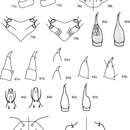Description
provided by Zookeys
Gnathosoma. Pedipalps 5-segmented and end in a strong claw, which is complemented with a tooth in some species; they extend to the tip of the hypognathum or slightly beyond. Basifemur and telofemur are fused but retain the suture; each has a dorsolateral simple or spine-like seta. Pedipalp tibiotarsus short and cone-like. Subcapitulum with 4 pairs of setae (hg1–4). Seta hg1 longest and in some species bent at 90 degrees, though not geniculate as in Bonziinae. Adoral setae present or absent. Chelicera with seta present or absent.
Idiosoma, dorsal. Proterosomal shield weakly sclerotized and ill-defined, granulated or papillated; some species possess subcuticular reticulations.
Idiosoma, ventral. Coxae I–II separate or fused medially into a single sternal shield. Coxae III–IV contiguous on either side, restricted to area around trochantral bases. Dorsal cupules im present laterad to e1; ventral cupules ih present near h2, anal plates. Legs shorter than body. Tarsi never constricted apically so as to end in lobes. Apices of solenidia cylindrical, not swollen as in Coleoscirus and Scutascirus. Trichobothrium on leg tibia IV present. Ambulacral claws smooth and occur on either side of a 4-rayed empodium.
- license
- cc-by-3.0
- copyright
- Michael J. Skvarla, J. Ray Fisher, Ashley P. G. Dowling
- bibliographic citation
- Skvarla M, Fisher J, Dowling A (2014) A review of Cunaxidae (Acariformes, Trombidiformes): Histories and diagnoses of subfamilies and genera, keys to world species, and some new locality records ZooKeys 418: 1–103
- author
- Michael J. Skvarla
- author
- J. Ray Fisher
- author
- Ashley P. G. Dowling

